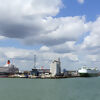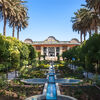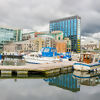12 Nights | Europe
You will visit the following 9 places:

Belfast
Belfast (meaning: "mouth of the sandbanks") is the capital and largest city of Northern Ireland, the second-largest city in Ireland after Dublin, and is situated around the River Lagan, which runs through the city. It is a port city known as the birthplace of the RMS Titanic, and for its political murals, documenting the ‘Troubles’ of the 20th century. Today, Belfast remains a centre for industry, as well as the arts, higher education, business, and law, and is the economic engine of Northern Ireland. The city suffered greatly during the period of conflict called "the Troubles", but latterly has undergone a sustained period of calm, free from the intense political violence of former years, and substantial economic and commercial growth. Additionally, Belfast city centre has undergone considerable expansion and regeneration in recent years, notably around Victoria Square.

Waterford
Waterford is the oldest city in Ireland famous for its crystal ware and intriguing medieval history. Located on the River Suir, Waterford was once one of the most important European ports in times past. Today, Waterford still maintains its 'small Irish town' feel, and has a much more relaxed vibe than the larger cities, whilst still providing for most traveler's tastes. Appealing most, perhaps, to interests including history, culture, music and arts. Waterford, like most Irish towns, has a lot of pubs.

Londonderry
Derry is the second-largest city in Northern Ireland and the fourth-largest city on the island of Ireland. The name Derry is an anglicisation of the Irish name Daire or Doiremeaning "oak grove". In 1613, the city was granted a Royal Charter by King James I and gained the "London" prefix to reflect the funding of its construction by the London guilds. While the city is more usually known colloquially as Derry, Londonderry is also commonly used and remains the legal name. The old walled city lies on the west bank of the River Foyle, which is spanned by two road bridges and one footbridge. The city now covers both banks (Cityside on the west and Waterside on the east). The district administered by Derry City and Strabane District Council contains both Londonderry Port and City of Derry Airport.

Southampton
Southampton is the largest city in the county of Hampshire on the south coast of England, and is situated 120 kilometres (75 mi) south-west of London and 30 kilometres (19 mi) north-west of Portsmouth. Southampton is a major port and the closest city to the New Forest. It lies at the northernmost point of Southampton Water at the confluence of the River Test and River Itchen, with the River Hamble joining to the south of the urban area. The local authority is Southampton City Council, which is a unitary authority. Just over a quarter of the jobs available in the city are in the health and education sector. A further 19 per cent are property and other business and the third largest sector is wholesale and retail, which accounts for 16.2 percent. Between 1995 and 2004, the number of jobs in Southampton has increased by 18.5 per cent. Southampton has always been a port, and the docks have long been a major employer in the city. In particular, it is a port for cruise ships; its heyday was the first half of the 20th century, and in particular the inter-war years, when it handled almost half the passenger traffic of the UK. Today it remains home to luxury cruise ships, as well as being the largest freight port on the Channel coast and fourth largest UK port by tonnage, with several container terminals. Unlike some other ports, such as Liverpool, London, and Bristol, where industry and docks have largely moved out of the city centres leaving room for redevelopment, Southampton retains much of its inner-city industry.

Galway City
Galway is a city in County Galway, Republic of Ireland. It is the fifth largest and the fastest-growing city in Ireland. Located on the west coast of Ireland, the city’s hub is 18th-century Eyre Square, a popular meeting spot surrounded by shops and traditional pubs that often offer live Irish folk music. Galway is famed as Ireland's Cultural Heart and is renowned for its vibrant lifestyle and numerous festivals, celebrations and events. Every July, Galway hosts the Galway Arts Festival which is known for its famous Macnas parade.

Cork
Cork - meaning "marsh", is a city in Ireland located in the South-West Region in the province of Munster. With a population of 125,622, it is the second largest city in the state and the third most populous on the island of Ireland. The city is built on the River Lee which splits into two channels at the western end of the city; the city centre is divided by these channels. They reconverge at the eastern end where the quays and docks along the river banks lead outwards towards Lough Mahon and Cork Harbour, one of the world's largest natural harbours. The city's cognomen of "the rebel city" originates in its support for the Yorkist cause during the English 15th century Wars of the Roses. Corkonians often refer to the city as "the real capital" in reference to the city's role as the centre of anti-treaty forces during the Irish Civil War.

Iran
Iran is an Islamic republic on the Persian (Arabian) Gulf with historical sites dating to the Persian Empire. Comprising a land area of 1,648,195 km2 (636,372 sq mi), it is the second-largest country in the Middle East and the 18th-largest in the world. It is heir to one of the world's oldest civilizations, beginning with the formation of the Proto-Elamite and Elamite kingdoms in 3200–2800 BC. Boasting spectacular landscapes and rich tapestry of ancient cultures and religions, Iran is highly welcoming and easy on the wallet (though you can only use cash), offering plenty of bang for your buck. Its treasure chest of attractions include ancient Persian monuments, lavish Qajar mansions, Silk Road caravanserais, world-renowned museums and art galleries in the bustling capital of Tehran, and the magnificent Safavid gardens in Esfahan that encircle some of the world’s most hauntingly beautiful mosques, adorned with mesmerizing turquoise tile-work.

Dublin South
Dublin is the largest and capital city of Ireland. The English name is derived from the Irish name Dubh Linn, meaning "black pool". It is a primate city with an urban population of over 1 million, containing almost 25% of the country's population. Dublin is situated near the midpoint of Ireland's east coast, at the mouth of the River Liffey, and at the centre of the Dublin Region. The city is listed by the Globalization and World Cities Research Network (GaWC) as a global city, with a ranking of "Alpha-", placing it among the top thirty cities in the world. It is a historical and contemporary centre for education, the arts, administration, economy and industry.






